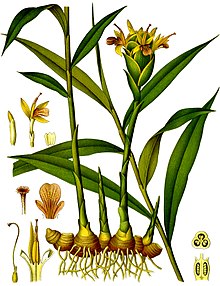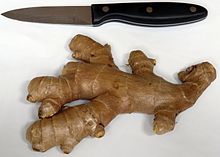(Zingiberis officinalis)
---Ginger is native to India and China. It takes its name from the Sanskrit word stringa-vera, which means “with a body like a horn”, as in antlers.
---Ginger is an herb. The rhizome (underground stem) is used as a spice and also as a medicine. It can be used fresh, dried and powdered, or as a juice or oil.
---Ginger is commonly used to treat various types of “stomach problems,” including motion sickness, morning sickness, colic, upset stomach, gas, diarrhea, nausea caused by cancer treatment, nausea and vomiting after surgery, as well as loss of appetite.
The oil made from ginger is sometimes applied to the skin to relieve pain.Some people pour the fresh juice on their skin to treat burns.
---Ginger is native to southestern Asia, but is widely cultivated in tropical countries throughout the world. The rhizome is used in cooking and folk medicine. The pungent, sweet taste is due to the presence of two oleoresins, gingerol and shogaol, and volatile oils. Many of the traditional folk medical uses have been verified by modern pharmacology.
 |
| () |
 |
| Fresh ginger rhizome. |
 |
| Ginger section |
Properties: Aromatic, carminative, diaphoretic, stimulant, diuretic.
What it affects: stomach, intestines, joints, muscles, and circulation.
Preparation and amount:
Infusion: steep for 5-15 min and drink 1 fluid oz. at a time.
Decoction: simmer 5-15 min. and take 2 oz. 3 x a day.
Tincture: 15-60 drops 3 x a day
Fluid extract: Take 5-20 drops 3 x a a day
Syrup: drink 1/2-1 tsp 3 x a day
Powder: drink 2-4 #0 capsules (10-20 grains) 3 x a day. take every 2 hours for nausea and vomiting.
Purposes:
Internally, ginger promotes cleansing of the system through perspiration. Take hot, the tea is good for suppressed menstruation and scanty urine. It brings heat into the system and stimulates digestion. Taken in frequent doses, it will raise body temperature. It is without a peer among herbs dealing with sea sickness, air sickness, and every other kind of motion sickness. It is helpful in reducing flatulent colic; and, when taken with laxative herbs,it makes their effect milder. It fights inflammation, cleanses the colon, reduces spasms and cramps, and stimulates circulation. Take it at the onset of a cold, to ease the effects of the usual symptoms. It is used for contagious diseases,coughs, cramps, indigestion, gas headache, colon spasms, morning sickness, nausea, sinus congestion, and stomach spasms.It is strong antioxidant and germ killer for sore and wounds. To stimulates the flow of saliva and soothe as sores and wounds. To stimulates the flow of saliva and soothe a sore throat, chew the rootstock as is. It protects the liver and stomach, and is useful for bowel disorders, arthritis, fever, hot flashes, indigestion, muscle pain, and vomiting.
Externally, ginger is used as a fomentation in cases of mumps.
Preparation and amount:
Infusion: steep for 5-15 min and drink 1 fluid oz. at a time.
Decoction: simmer 5-15 min. and take 2 oz. 3 x a day.
Tincture: 15-60 drops 3 x a day
Fluid extract: Take 5-20 drops 3 x a a day
Syrup: drink 1/2-1 tsp 3 x a day
Powder: drink 2-4 #0 capsules (10-20 grains) 3 x a day. take every 2 hours for nausea and vomiting.
Purposes:
Internally, ginger promotes cleansing of the system through perspiration. Take hot, the tea is good for suppressed menstruation and scanty urine. It brings heat into the system and stimulates digestion. Taken in frequent doses, it will raise body temperature. It is without a peer among herbs dealing with sea sickness, air sickness, and every other kind of motion sickness. It is helpful in reducing flatulent colic; and, when taken with laxative herbs,it makes their effect milder. It fights inflammation, cleanses the colon, reduces spasms and cramps, and stimulates circulation. Take it at the onset of a cold, to ease the effects of the usual symptoms. It is used for contagious diseases,coughs, cramps, indigestion, gas headache, colon spasms, morning sickness, nausea, sinus congestion, and stomach spasms.It is strong antioxidant and germ killer for sore and wounds. To stimulates the flow of saliva and soothe as sores and wounds. To stimulates the flow of saliva and soothe a sore throat, chew the rootstock as is. It protects the liver and stomach, and is useful for bowel disorders, arthritis, fever, hot flashes, indigestion, muscle pain, and vomiting.
Externally, ginger is used as a fomentation in cases of mumps.
Plants description:
A perennial creeping plant, with thick tuberous rhizome, producing a an erect stem 30 - 100 cm (1-3 ft) tall. The lance-shaped leaves are bright green, 15 - 20 cm (6-8 in) long, with a prominent longitudinal rib, enclosing conical clusters of small yellow-green flowers marked with purple speckles. It is propagated from rhizome cuttings, planted on rich, well drained loam. It requires a tropical climate with both a heavy rain season and a hot dry season. Plants shoot in ten days and are harvested after nine to ten months
No comments:
Post a Comment